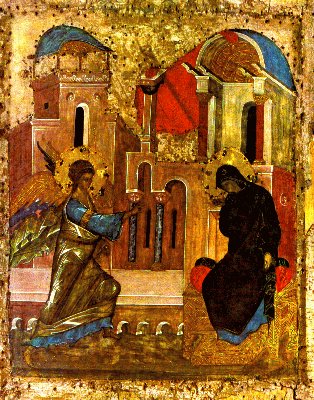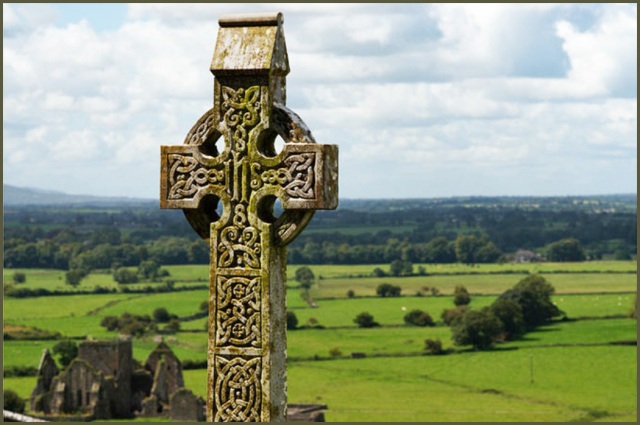On March 25, the Orthodox Church celebrates the Feast of the Annunciation. On this major feast day, we remember the Incarnation — the occasion the Word of God took on human nature; the Infinite Creator became a finite creature; Eternity entered into the flow of history; and the Immortal One became mortal so that we might attain immortality.
The Incarnation was and continues to be one of the most momentous events in all history. It prepared the way for Jesus’ life on earth as one of us which would culminate in his saving death on the Cross. In modern parlance, it was a real game changer. In the Incarnation the ontology of the universe was restructured. This cosmic realignment is hinted at in the following prayer to the Virgin Mary in the Small Compline.
Spotless, undefiled, immaculate, unstained, pure Virgin, Lady and Bride of God, by your wondrous conceiving you united God the Word with human beings and joined the fallen nature of our race to heavenly things.
In the Incarnation God’s infinite transcendence over creation is bridged through Immanuel “God With Us.” In the Incarnation heaven is united with earth, and conversely fallen humanity begins to reverse course becoming restored to its former exalted state. As man Jesus experienced death for all humanity and rose on the third day victorious over death. Mary’s Yes made all this possible.
What Mary’s Yes Means For Us
Luke 1:26-38 recounts the Archangel Gabriel’s announcement to Mary that she has been highly favored by God and that she would give birth to Jesus, the Son of the Most High. Mary of her own free will consented to becoming the Theotokos (God-Bearer). Mary was indeed chosen by God, but she was not “elected” in the hyper-Calvinistic sense of zero real choice. Mary’s Yes is an affirmation of human free will and the possibility of a true and genuine uncoerced love.
Mary’s Yes is a good example of synergistic cooperation with God’s grace. Her Yes is also an example of Christian discipleship. Christian discipleship begins with our saying Yes to God. Saying Yes to God is a sign of our faith and obedience. Christian discipleship is a process and a journey. A lifetime of saying Yes to God results in our spiritual transformation, that is, theosis. The choices we make in discipleship do not happen in a vacuum, devoid of the active presence of the Holy Spirit – divine initiative is a critical necessity. The trajectory of Mary’s life shows the impact of her radical commitment to Christ: from the Annunciation by the Archangel Gabriel, to the manger in Bethlehem, to her standing at the Cross. There is much we can learn from her Yes.
The significance of Luke 1 is brought out through a comparison with Genesis 3. Irenaeus of Lyons contrasted Mary’s obedience with Eve’s disobedience.
[Eve] having become disobedient, was made the cause of death, both to herself and to the entire human race; so also did Mary, having a man betrothed [to her], and being nevertheless a virgin, by yielding obedience, become the cause of salvation, both to herself and the whole human race.
And thus also it was that the knot of Eve’s disobedience was loosed by the obedience of Mary. For what the virgin Eve had bound fast through unbelief, this did the virgin Mary set free through faith. (Against Heresies 3.22.4; ANF vol. I p. 455)
Irenaeus’ insight that the Virgin Mary is the Second Eve builds on the Apostle Paul’s insight that Jesus Christ is the Second Adam (Romans 5:12-21). Later Church Fathers would expand on these insights giving rise to a rich heritage of hymns and writings about the mystery of the Incarnation. One of the most regrettable aspect of my Protestant heritage, has been the way Protestants shunned viewing Mary as the Second Eve and in so doing departed from the historic Christian Faith.
Rejoice Unwedded Bride!
In present day American culture, the phrase “She said Yes!” indicates that the woman has accepted the man’s proposal of marriage. This marks a happy moment that looks to the future where the two become one flesh and start a family. This reflects the natural order of things set forth in Genesis 1-2. Mary’s consent to becoming the Theotokos (God-Bearer) marks the introduction of a new order that supersedes the old order. The title “Unwedded Bride” refers to the fact that Mary was betrothed to Joseph but never married to him; yet despite her never having entered into wedlock, Mary miraculously conceived and gave birth to Jesus. This was a sign that God was doing a marvelous new thing.
Readers are invited to listen to Fr. Josiah Trenham’s podcast “Godly Marriage and Virginity – Paths to Holiness.” At around the 5:40 mark, Fr. Josiah writes on the white board: “The Incarnation changed EVERYTHING.” Fr. Josiah’s presentation helps us to understand how the Incarnation led to a new understanding of marriage, virginity and human existence. At the 15:35 mark, Fr. Josiah states: “Marriage is good, but the monastic life is better.” This helps us to understand why the Orthodox Church honors Mary as the Unwedded Bride.
Sadly, the fear of Roman Catholicism so widespread among Protestants, has led to their ignoring the feast day of the Annunciation – March 25th. After becoming Orthodox, my appreciation of the Incarnation grew as a result of hearing the hymns and prayers that celebrate the Annunciation. Understanding the Incarnation helps us to appreciate the significance of Christmas. Christmas Day – December 25th – is more than the birth of a special Child but also about March 25th – the day the Divine Word entered into our fallen world and began reversing the Fall.
The Orthodox Church celebrates the Annunciation with the hymn “Rejoice Unwedded Bride.”
When the archangel understood the mysterious command,
He came to the house of Joseph with haste and proclaimed to the unwedded Lady:
The One Who bowed the heavens by His condescension
is contained wholly and without change in you!
As I behold Him in your womb, taking the form of a servant, I am frightened, but cry:
Rejoice, unwedded Bride!
Why We Need Feast Days
Anniversaries, holidays, and feast days are important to who we are. They help us remember what is important to us, what we prize and cherish. The pressures of everyday living have a flattening effect on our souls. For this reason, human beings need a break from mundane existence to reconnect with the greater transcendent reality – Christ and his Kingdom. These special days are a matter of the heart. Without this inner meaning, holidays become empty markers filled with delicious meals, sweet desserts, accompanied with pleasant socializing or frenzied partying. This is why the Orthodox Church prepares for the celebration of feast days with fasting and prayer. These spiritual disciplines help prepare us to enter into the reality behind the feast day.
The church year helps us to remember our history and our heroes (saints). The church calendar reminds us that we belong to a holy nation – the Church (1 Peter 1:9-10). Where Memorial Day, Labor Day, Thanksgiving Day all serve to remind those living in the US of their American identity, the church calendar reminds Orthodox Christians of a greater history which goes back several millennia and spans many cultures and ethnicities all over the world.
Human history is not just secular history of people competing for power, wealth, and glory but also redemptive history in which Christ’s divine grace flows through the Church transforming lives. This is the basis for the Orthodox Church’s celebration of the lives of the saints. To celebrate the lives of the saints as we do on feast days is to celebrate the kingdom of God – Christ’s reclaiming fallen human beings from Satan and restoring them to the glory of children of God.

Celebrating at Annunciation Greek Orthodox Church – Newburyport, MA source
Happy Annunciation Day!
Where December 25th celebrates Christ’s birth as a baby, March 25th celebrates the Word becoming flesh for our salvation. The feast of the Annunciation belongs to all Christians: Orthodox, Roman Catholic, and Protestant. March 25th, the Feast of the Annunciation, is one of the great feast days in the Orthodox Church. We celebrate it in songs, prayers, the Eucharist, and oftentimes with a special meal following the church service.
It is unfortunate that for many Protestants and Evangelicals March 25th has become a forgotten holiday. Protestants should likewise celebrate the Feast of the Annunciation. It is biblical (Luke 1:34-35; John 1:14; Isaiah 9:6) and affirms one of the core truths of Christianity. Celebrating the Annunciation will guard Protestants against heresies such as Gnosticism and dualism. It will also help Protestants and Evangelicals reconnect with the early Church.
There is no reason why Reformed Christians should shy away from celebrating the Annunciation. The Second Helvetic Confession, Chapter 24 “Of Holy Days, Fasts and the Choice of Foods,” teaches:
Moreover, if in Christian liberty the churches religiously celebrate the memory of the Lord’s nativity, circumcision, passion, resurrection, and of his ascension into heaven, and the sending of the Holy Spirit upon his disciples, we approve of it highly. . . .
Here, we find a major Reformed confession giving hearty approval to the feast days pertaining to the life of Christ. It is curious that the confession makes no mention of the Annunciation, nevertheless, it seems that Reformed churches did at one time observe feast days celebrating the major events in the life of Christ. Thus, it would be good for Reformed churches to reinstate the ancient feast day of the Annunciation. It would also be good for Reformed Christians to visit an Orthodox Sunday worship service this coming Sunday and observe how the Orthodox celebrate the Annunciation. Come and see!
Robert Arakaki









Recent Comments